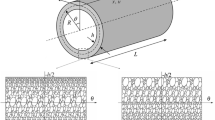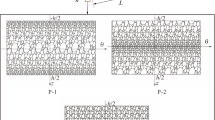Abstract
In this paper, free vibrations of cylindrical nanoshells made of nanoporous metal foam are investigated for the first time. Based on the modified couple stress theory and Love’s thin shell theory, the governing equations of the present system are derived by using Hamilton’s principle. Two types of nanoporosity distribution are considered in the construction of the nanoporous shells. Then, the Navier method and Galerkin method are utilized to solve natural frequencies of the nanoporous shells under different boundary conditions. Afterwards, a detailed parametric study is conducted. Results show that the nanoporosity type, the material length scale parameter, the porosity coefficient, the length-to-radius ratio, and the radius-to-thickness ratio play important role on the free vibrations of nanoporous shells. To check the validity of the present analysis, the results are compared with those in previous studies for the special cases.






Similar content being viewed by others
References
Alibeigloo A, Shaban M (2013) Free vibration analysis of carbon nanotubes by using three-dimensional theory of elasticity. Acta Mech 224:1415–1427
Ansari R, Gholami R, Norouzzadeh A, Sahmani S (2015) Size-dependent vibration and instability of fluid-conveying functionally graded microshells based on the modified couple stress theory. Microfluid Nanofluidics 19:509–522
Ansari R, Pourashraf T, Gholami R, Rouhi H (2016) Analytical solution approach for nonlinear buckling and postbuckling analysis of cylindrical nanoshells based on surface elasticity theory. Appl Math Mech 37:903–918
Asghari M, Rahaeifard M, Kahrobaiyan MH, Ahmadian MT (2011) The modified couple stress functionally graded Timoshenko beam formulation. Mater Des 32:1435–1443
Barati MR (2018) A general nonlocal stress–strain gradient theory for forced vibration analysis of heterogeneous porous nanoplates. Eur J Mech A/Solids 67:215–230
Barati MR, Zenkour AM (2017) Investigating post-buckling of geometrically imperfect metal foam nanobeams with symmetric and asymmetric porosity distributions. Compos Struct 182:91–98
Biener J, Wittstock A, Zepeda-Ruiz LA et al (2009) Surface-chemistry-driven actuation in nanoporous gold. Nat Mater 8:47
Bringa EM, Monk JD, Caro A et al (2011) Are nanoporous materials radiation resistant? Nano Lett 12:3351–3355
Chen D, Yang J, Kitipornchai S (2015) Elastic buckling and static bending of shear deformable functionally graded porous beam. Compos Struct 133:54–61
Chen D, Kitipornchai S, Yang J (2016) Nonlinear free vibration of shear deformable sandwich beam with a functionally graded porous core. Thin-Walled Struct 107:39–48
Cheng IC, Hodge AM (2013) Strength scale behavior of nanoporous Ag, Pd and Cu foams. Scr Mater 69:295–298
Detsi E, Punzhin S, Rao J et al (2012) Enhanced strain in functional nanoporous gold with a dual microscopic length scale structure. ACS Nano 6:3734–3744
Ebrahimi N, Beni YT (2016) Electro-mechanical vibration of nanoshells using consistent size-dependent piezoelectric theory. Steel Compos Struct 22:1301–1336
Eringen AC (1980) Mechanics of continua. Robert E Krieger Publ Co, Huntington, p 606
Eringen AC, Edelen DGB (1972) On nonlocal elasticity. Int J Eng Sci 10:233–248
Ghadiri M, SafarPour H (2017) Free vibration analysis of size-dependent functionally graded porous cylindrical microshells in thermal environment. J Therm Stress 40:55–71
Gibson LJ, Ashby MF (1982) The mechanics of three-dimensional cellular materials. Proc R Soc A Math Phys Eng Sci 382:43–59
Gurtin ME, Ian Murdoch A (1978) Surface stress in solids. Int J Solids Struct 14:431–440
Heydari H, Moosavifard SE, Shahraki M, Elyasi S (2017) Facile synthesis of nanoporous CuS nanospheres for high-performance supercapacitor electrodes. J Energy Chem 26:762–767
Jabbari M, Mojahedin A, Khorshidvand AR, Eslami MR (2014) Buckling analysis of a functionally graded thin circular plate made of saturated porous materials. J Eng Mech 140:287–295
Jin H-J, Wang X-L, Parida S et al (2009) Nanoporous Au–Pt alloys as large strain electrochemical actuators. Nano Lett 10:187–194
Ke LL, Wang Y (2011) Size effect on dynamic stability of functionally graded microbeams based on a modified couple stress theory. Compos Struct 93:342–350
Ke LL, Wang YS, Reddy JN (2014a) Thermo-electro-mechanical vibration of size-dependent piezoelectric cylindrical nanoshells under various boundary conditions. Compos Struct 116:626–636
Ke LL, Wang YS, Yang J, Kitipornchai S (2014b) The size-dependent vibration of embedded magneto-electro-elastic cylindrical nanoshells. Smart Mater Struct 23:125036
Kheibari F, Beni YT (2017) Size dependent electro-mechanical vibration of single-walled piezoelectric nanotubes using thin shell model. Mater Des 114:572–583
Lam DCC, Yang F, Chong ACM et al (2003) Experiments and theory in strain gradient elasticity. J Mech Phys Solids 51:1477–1508
Li J, Wang S, Xiao T et al (2017) Controllable preparation of nanoporous Ni3S2 films by sulfuration of nickel foam as promising asymmetric supercapacitor electrodes. Appl Surf Sci 420:919–926
Loy CT, Lam KY (1997) Vibration of cylindrical shells with ring support. Int J Mech Sci 39:455–471
Magnucka-Blandzi E (2010) Non-Linear analysis of dynamic stability of metal foam circular plate. J Theor Appl Mech 48:207–217
Mehralian F, Beni YT (2018) Vibration analysis of size-dependent bimorph functionally graded piezoelectric cylindrical shell based on nonlocal strain gradient theory. J Braz Soc Mech Sci Eng 40:27
Mehralian F, Tadi Beni Y, Ansari R (2016) Size dependent buckling analysis of functionally graded piezoelectric cylindrical nanoshell. Compos Struct 152:45–61
Mohammadi K, Mahinzare M, Ghorbani K, Ghadiri M (2017) Cylindrical functionally graded shell model based on the first order shear deformation nonlocal strain gradient elasticity theory. Microsyst Technol 24:1133–1146
Nieman GW, Weertman JR, Siegel RW (1992) Mechanical behavior of nanocrystalline metals. Nanostructured Mater 1:185–190
Park SK, Gao XL (2006) Bernoulli–Euler beam model based on a modified couple stress theory. J Micromechanics Microengineering 16:2355–2359
Park SK, Gao XL (2008) Variational formulation of a modified couple stress theory and its application to a simple shear problem. Zeitschrift fur Angew Math und Phys 59:904–917
Park H, Ahn C, Jo H et al (2014) Large-area metal foams with highly ordered sub-micrometer-scale pores for potential applications in energy areas. Mater Lett 129:174–177
Pia G, Delogu F (2013) On the elastic deformation behavior of nanoporous metal foams. Scr Mater 69:781–784
Razavi H, Babadi AF, Tadi Beni Y (2017) Free vibration analysis of functionally graded piezoelectric cylindrical nanoshell based on consistent couple stress theory. Compos Struct 160:1299–1309
Rouhi H, Ansari R, Darvizeh M (2016) Size-dependent free vibration analysis of nanoshells based on the surface stress elasticity. Appl Math Model 40:3128–3140
Sahmani S, Aghdam MM (2017) A nonlocal strain gradient hyperbolic shear deformable shell model for radial postbuckling analysis of functionally graded multilayer GPLRC nanoshells. Compos Struct 178:97–109
Sahmani S, Aghdam MM, Bahrami M (2016) Size-dependent axial buckling and postbuckling characteristics of cylindrical nanoshells in different temperatures. Int J Mech Sci 107:170–179
Sahmani S, Aghdam MM, Bahrami M (2017) Surface free energy effects on the postbuckling behavior of cylindrical shear deformable nanoshells under combined axial and radial compressions. Meccanica 52:1329–1352
Schiøtz J, Vegge T, Di Tolla FD, Jacobsen KW (1999) Atomic-scale simulations of the mechanical deformation of nanocrystalline metals. Phys Rev B Condens Matter Mater Phys 60:11971–11983
Shin H, Liu M (2005) Three-dimensional porous Copper–Tin alloy electrodes for rechargeable lithium batteries. Adv Funct Mater 15:582–586
Şimşek M, Reddy JN (2013) Bending and vibration of functionally graded microbeams using a new higher order beam theory and the modified couple stress theory. Int J Eng Sci 64:37–53
Soedel W (2004) Vibrations of shells and plates. CRC Press, Boca Raton
Soleimani I, Beni YT (2018) Vibration analysis of nanotubes based on two-node size dependent axisymmetric shell element. Arch Civ Mech Eng 18:1345–1358
Tadi Beni Y, Mehralian F, Razavi H (2015) Free vibration analysis of size-dependent shear deformable functionally graded cylindrical shell on the basis of modified couple stress theory. Compos Struct 120:65–78
Tadi Beni Y, Mehralian F, Zeighampour H (2016) The modified couple stress functionally graded cylindrical thin shell formulation. Mech Adv Mater Struct 23:791–801
Toupin RA (1962) Elastic materials with couple-stresses. Arch Ration Mech Anal 11:385–414
Van Vliet KJ, Li J, Zhu T et al (2003) Quantifying the early stages of plasticity through nanoscale experiments and simulations. Phys Rev B 67:104105
Wang YQ (2018) Electro-mechanical vibration analysis of functionally graded piezoelectric porous plates in the translation state. Acta Astronaut 143:263–271
Wang Q, Varadan VK (2007) Application of nonlocal elastic shell theory in wave propagation analysis of carbon nanotubes. Smart Mater Struct 16:178–190
Wang YQ, Zu JW (2017a) Analytical analysis for vibration of longitudinally moving plate submerged in infinite liquid domain. Appl Math Mech 38:625–646
Wang YQ, Zu JW (2017b) Nonlinear steady-state responses of longitudinally traveling functionally graded material plates in contact with liquid. Compos Struct 164:130–144
Wang YQ, Zu JW (2017c) Vibration behaviors of functionally graded rectangular plates with porosities and moving in thermal environment. Aerosp Sci Technol 69:550–562
Wang YQ, Zu JW (2017d) Instability of viscoelastic plates with longitudinally variable speed and immersed in ideal liquid. Int J Appl Mech 9:1750005
Wang YQ, Zu JW (2018) Nonlinear dynamics of a translational FGM plate with strong mode interaction. Int J Struct Stab Dyn 18:1850031
Wang R, Wang C, Cai W, Ding Y (2010) Ultralow-platinum-loading high-performance nanoporous electrocatalysts with nanoengineered surface structures. Adv Mater 22:1845–1848
Wang YQ, Huang XB, Li J (2016) Hydroelastic dynamic analysis of axially moving plates in continuous hot-dip galvanizing process. Int J Mech Sci 110:201–216
Wang YQ, Ye C, Zu JW (2018a) Identifying the temperature effect on the vibrations of functionally graded cylindrical shells with porosities. Appl Math Mech 39:1587–1604
Wang YQ, Zhao HL, Ye C, Zu JW (2018b) A porous microbeam model for bending and vibration analysis based on the sinusoidal beam theory and modified strain gradient theory. Int J Appl Mech 10:1850059
Wittstock A, Zielasek V, Biener J et al (2010) Nanoporous gold catalysts for selective gas-phase oxidative coupling of methanol at low temperature. Science 327:319–322
Yamakov V, Wolf D, Phillpot SR et al (2004) Deformation-mechanism map for nanocrystalline metals by molecular-dynamics simulation. Nat Mater 3:43–47
Yang F, Chong ACM, Lam DCC, Tong P (2002) Couple stress based strain gradient theory for elasticity. Int J Solids Struct 39:2731–2743
Zeighampour H, Beni YT (2014a) Size-dependent vibration of fluid-conveying double-walled carbon nanotubes using couple stress shell theory. Phys E Low-Dimens Syst Nanostructures 61:28–39
Zeighampour H, Beni YT (2014b) Analysis of conical shells in the framework of coupled stresses theory. Int J Eng Sci 81:107–122
Zeighampour H, Beni YT (2014c) Cylindrical thin-shell model based on modified strain gradient theory. Int J Eng Sci 78:27–47
Zeighampour H, Beni YT (2015) A shear deformable cylindrical shell model based on couple stress theory. Arch Appl Mech 85:539–553
Acknowledgements
This research was supported by the National Natural Science Foundation of China (Grant no. 11672071) and the Fundamental Research Funds for the Central Universities (Grant no. N170504023).
Author information
Authors and Affiliations
Corresponding author
Additional information
Publisher's Note
Springer Nature remains neutral with regard to jurisdictional claims in published maps and institutional affiliations.
Appendix
Appendix
The elements in the matrix of Eq. (53) are given by (porosity distribution 1):
where \(k_{m} = \frac{m\pi }{L}\).
The elements in the matrix of Eq. (53) are given by (porosity distribution 2):
Rights and permissions
About this article
Cite this article
Wang, Y.Q., Liu, Y.F. & Zu, J.W. On scale-dependent vibration of circular cylindrical nanoporous metal foam shells. Microsyst Technol 25, 2661–2674 (2019). https://doi.org/10.1007/s00542-018-4262-y
Received:
Accepted:
Published:
Issue Date:
DOI: https://doi.org/10.1007/s00542-018-4262-y




